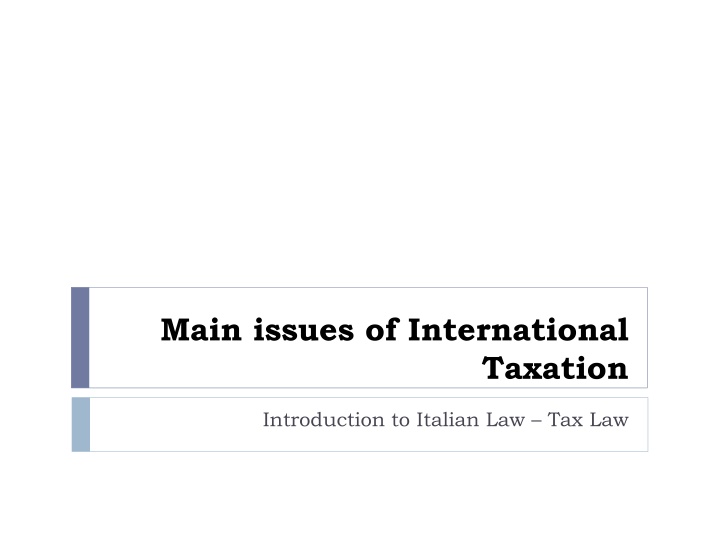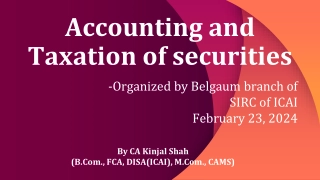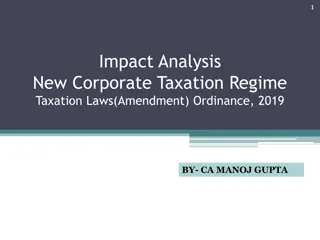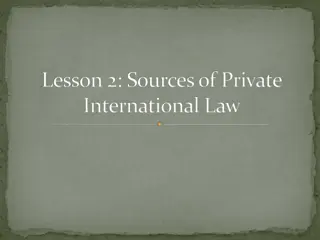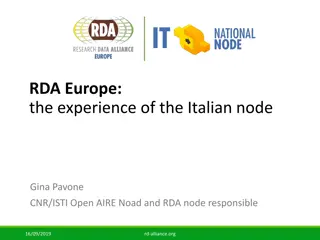Overview of International Taxation in Italian Law
International taxation refers to rules governing tax laws in different countries, covering various aspects such as cross-border trade, investments, and taxation of individuals working abroad. Tax treaties play a crucial role in limiting the taxation power of treaty partners, with over 2,000 bilateral income tax treaties currently in effect. The relationship between tax treaties and domestic tax legislation is managed based on the supremacy of treaties, ensuring they prevail in cases of conflict. In Italy, tax treaties hold special significance, and subsequent domestic laws cannot override their provisions.
Download Presentation

Please find below an Image/Link to download the presentation.
The content on the website is provided AS IS for your information and personal use only. It may not be sold, licensed, or shared on other websites without obtaining consent from the author.If you encounter any issues during the download, it is possible that the publisher has removed the file from their server.
You are allowed to download the files provided on this website for personal or commercial use, subject to the condition that they are used lawfully. All files are the property of their respective owners.
The content on the website is provided AS IS for your information and personal use only. It may not be sold, licensed, or shared on other websites without obtaining consent from the author.
E N D
Presentation Transcript
Main issues of International Taxation Introduction to Italian Law Tax Law
International taxation a preview Scope and goals of international taxation; Tax treaties, tax treaties models; International double taxation: issues, relief mechanisms and MAP. 1. 2. 3. 2 02/10/2024
What is international taxation? It is a system of rules referring to international aspects of the income tax law of certain countries; Scope of international taxation: it covers all tax issues arising under a country s tax law that includes some foreign elements; For example income tax concerning: Cross-border trade in goods and services; Cross-border manufacturing by a multinational enterprise; Cross-border investments by individuals or investment funds; Taxation of individuals working abroad; Digital economy. 3 02/10/2024
Tax treaties It doesn't exist an overriding international law of taxation, arising from customary international entities such as UN or OECD; practice or from A great role is however played by the tax treaties, which impose significant limitations on the taxation power of the treaty partners. Tax treaties represent an important aspect of international tax rules of most countries: over 2,000 bilateral income tax treaties are currently in effect,and the number is growing. 4 02/10/2024
Tax treaties Art. 2 of the Vienna Convention: A treaty is an international agreement concluded between states and governed by international law ; Tax treaties confer rights and impose obligations on the contracting states; Tax treaties don t impose tax. Rather, they limit the taxes otherwise imposed by a State; Treaties, once signed, are binding for the States, although to be effective on taxpayers they need to be incorporated into a domestic statute. 5 02/10/2024
Treaties and domestic law The relationship between tax treaties and domestic tax legislation, and the risk of a conflict, is often resolved according the supremacy to tax treaties; Basic principle: the treaty should prevail in the event of a conflict between the provisions of domestic law and a treaty ( treaty override ). This is the case of Italy, where a subsequent domestic law cannot override the provisions of a tax treaty, according to the specialty principle 6 02/10/2024
Objectives of tax treaties 1/3 The objective of tax treaties is to facilitate cross- border trade and investment by eliminating the tax impediments in cross-border flows; To achieve this goal, the most important provisions of a tax treaty are intended to eliminate the double taxation (operational objective); For example, tax treaties provide for: 1. Tie-breaker rules to avoid double residence; 2. Limit or eliminate source jurisdiction on certain types of income; 3. Require residence country to provide relief for source country tax either by granting exemption or a foreign tax credit. 7 02/10/2024
Objectives of tax treaties 2/3 Ancillary objectives: Moreover a tax treaty s aim is to prevent tax evasion, although few provisions are designed to achieve it; Elimination of discrimination against foreign nationals and nonresidents; Exchange of information between the Contracting States. It is an important tool in combatting fiscal evasion; Provide dispute resolution mechanisms; 8 02/10/2024
Objectives of tax treaties 3/3 A major objective of most tax treaties is to provide for reduced rates on withholding tax on certain investment income (dividends,interests,royalties); The goal is to provide for some sharing of tax yield between the source and the residence country 9 02/10/2024
Italy bilateral agreements Italy has entered in bilateral agreements with many foreign countries, within and outside EU, to avoid double taxation on income and property; These agreements establish the range of the power to set taxes in the two States; Depending on the categories involved, these agreements plan the possibility for both States to tax the same income ( concurrent taxation ) or, sometimes, the exclusive taxation by one State only http://www.finanze.gov.it/opencms/it/fiscalita-comunitaria-e- internazionale/convenzioni-e-accordi/convenzioni-per-evitare-le-doppie- imposizioni/ 10 02/10/2024
Model Tax Treaties // OECD OECD (Organization for Economic Co-operation and Development) Model Tax Convention on Income and on Capital the mission of the OECD is to promote policies that will improve the economic and social well-being of people around the world. set international standards on a wide range of topics: taxation, finance, environment, trade, social and welfare,competition,digitalization (see:https://www.oecd.org/) 11 02/10/2024
Model Tax Treaties The Oecd Model Tax Convention on Income and on Capital was first published, in draft form, in 1963 revised in 1977,1992 2017; A detailed commentary, organized on an article-by- article basis, accompanies the Oecd Model Treaty. It is very important with respect to the interpretation and application of (http://www.oecd.org/berlin/publikationen/43324465.pdf) The Oecd Model eliminates or mitigates double taxation by requiring the source country to give up some or all of its tax on certain categories of income earned by residents of the other treaty country. tax treaties; 12 02/10/2024
Model Tax Treaties Structure of the Oecd Model: http://www.oecd.org/tax/treaties/ ..\..\2020\10_InternationalTaxation\2014-model-tax-convention-articles.pdf Art.4:definition of resident ; Art.10:taxation of dividends; Art.11:taxation of interests; Art.12:taxation of royalties; Art.21:taxation of other income ; Art.26:exchange of information. 13 02/10/2024
International double taxation The term is not defined by the Oecd Model itself or in the Commentary to theTreaty; Def.: imposition of comparable income taxes by two or more sovereign countries on the same item of income of the same taxable person for the same taxable period juridical/legal definition; Economic concept of double taxation: it occurs whenever there is multiple taxation of the same items of economic income. 14 02/10/2024
The risk of double taxation Residence-source conflicts (1) Income Residence StateB StateA Residence-residence conflicts (2) Residence Residence StateB StateA 15 02/10/2024
The risk of double taxation (1) Residence-source conflicts:one country asserts the right to tax foreign- source income of a taxpayer because the taxpayer is resident of that country and another country asserts the right to tax the same income because the source of the income is in that country. When a person earns income from abroad, the tax claim of the source jurisdiction may overlap the claim of the residence jurisdiction; Consequently,foreign-source income earned by a resident of a country may be taxed by both the country of source and the country of residence, absent relief provisions designed to prevent double taxation; If income tax rates are low,the inefficiencies and unfairness caused by double taxation are modest enough to be bearable; But when tax rates reach the levels that now prevail, double-tax burdens can become onerous and interfere substantially with international commerce. 16 02/10/2024
Relief mechanisms No international consensus has been reached on the appropriate method for granting relief from international double taxation. However,the following methods are in common use: Exemption method; Credit method. 17 02/10/2024
Exemption method The residence country provides its taxpayers with an exemption for foreign source income; The country of residence taxes its residents only on their domestic-source incomes, while foreign-source incomes are exempted (territorial basis of taxation); This method completely eliminates residence-source international double taxation jurisdiction,the source country,is imposing tax; This method is relatively simple for the tax authorities to administer and is effective in eliminating international double taxation. because only one 18 02/10/2024
Credit method The residence country provides its taxpayers with a credit against taxes otherwise payable for income-taxes paid to a foreign country; Under this method, foreign taxes paid by the resident taxpayer on foreign-source domestic tax by the amount of the foreign tax. income reduce the 19 02/10/2024
Treaty aspects Exemption method Credit method Simplicity Low administrative burden Low level of tax planning activity Ability to deduct foreign losses against domestic income Need for expense allocation rules No deduction of foreign losses against domestic income High sensitivity to tax planning activity Complexity of rules on: (i) foreign tax credit limitation; and (ii) indirect tax credit High administrative burden 20 02/10/2024
The risk of double taxation (2) Residence-residence conflicts: two or more countries assert the right to tax the same income of a taxpayer because they claim the taxpayer is a resident of their country; Case of dual-resident taxpayer ; To exercise residence jurisdiction, a country must provide rules that classify individuals and legal entities either as residents or nonresidents. 21 02/10/2024
Tie-breaker rules for individuals Tie breaker rules for individuals: 1) Place where the individual has a permanent home; 2) Country in which the centre of the individual s vital interests is located; 3) Location of the individual s habitual dwelling; 4) Country of citizenship. If these rules are ineffective in making the individual a resident of only one country for treaty purposes, the competent tax authorities of the two countries are mandated to determine residence by mutual agreement 22 02/10/2024
Tie-breaker for legal entities Tie breaker rules for legal entities: where the effective place of management is located (art. 4.3 Oecd Model); Some treaties use place of incorporation as the tie- breaker rule if the company is incorporated in one of the treaty countries; Many treaties attempt to resolve conflicts over the residence of entities by referring the issue to the competent authorities. 23 02/10/2024
Mutual agreement procedure (MAP) Art. 25 Oced Model; The MAP allows the competent authorities of the contracting States to interact in order to resolve international tax disputes; aim: discuss cross-border taxation of specific transactions or situations with a view to coordinate the approach for the benefits of the taxpayers involved. 24 02/10/2024
